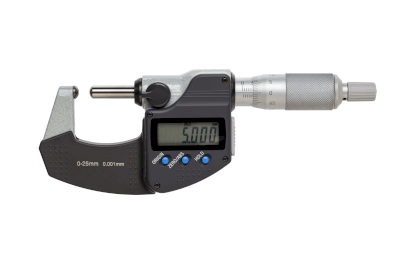What Is an Electronic Micrometer?

An electronic micrometer, also known as an electrical comparator, is a precision instrument that uses a contact-type measuring probe to convert small physical displacements into electrical signals for measurement. This device measures variations in electrical resistance, electrostatic capacitance, and electromagnetic induction resulting from probe displacement.
Uses of Electronic Micrometers
Electronic micrometers are used in precision engineering for measuring dimensions such as height, depth, and thickness. They are particularly useful for measuring eccentricity in rotating bodies, oscillation, and vibration in parts, and are prevalent in manufacturing where high accuracy is required. Most models can measure with a precision of up to 1µm.
Principle of Electronic Micrometers
Electronic micrometers function by detecting displacements using a contact probe connected to a converter that translates these physical changes into electrical signals. Differential transformers are commonly used in these devices for conversion.
1. Plunger Type
In the plunger type, the probe’s displacement is directly linked to a differential transformer. The transformer, with a movable iron core, responds to position changes, generating voltage differences that are amplified and measured.
2. Lever Type
The lever type uses an arm connected to a measuring probe, where the rotation of the arm moves the iron core of the transformer. This displacement is proportional to the probe movement, making it suitable for applications like measuring bearing deflection.
Characteristics of Electronic Micrometers
1. High Magnification
Electronic micrometers offer high magnification readings, typically ranging from 0.2 to 1µm. They provide flexible options with multiple magnification levels, allowing for varied measurement ranges.
2. Compact and Lightweight
Their compact and lightweight design makes them suitable for field use, and they can be operated remotely.
3. High Performance
These micrometers are known for their stability, precision, and ease of use.
Challenges of Electronic Micrometers
1. Measurement Stability
Contamination between the probe and the measured object can cause errors. Soft materials like rubber or plastic may deform under the probe, affecting accuracy. Additionally, variations in temperature between the micrometer and the object can lead to measurement errors, necessitating temperature control.
Regular maintenance and calibration using block gauges are essential for maintaining accuracy.
2. Reduction of Labor and Cost
Ensuring the zero point before measurement is crucial, and the time-consuming nature of contact measurements can vary based on operator skill. The use of different ratchet mechanisms during measurement can impact efficiency. Additionally, manual recording of measurements can be labor-intensive, highlighting the advantage of micrometers with digital output capabilities for efficiency.